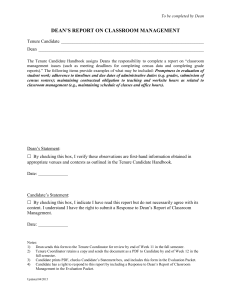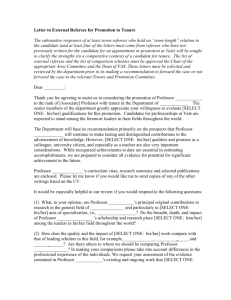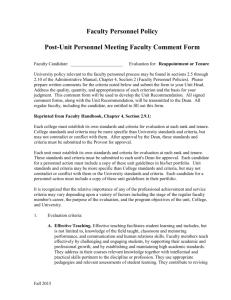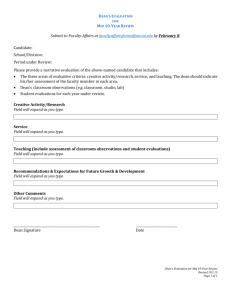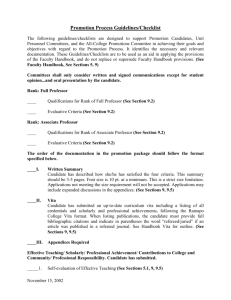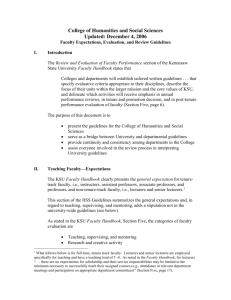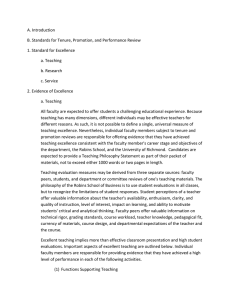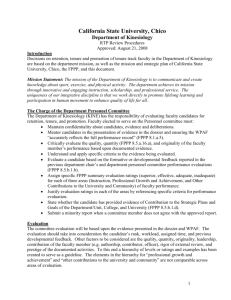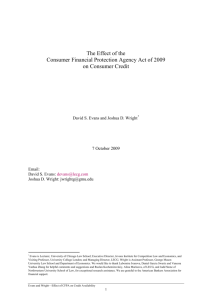College of Fine & Performing Arts
advertisement
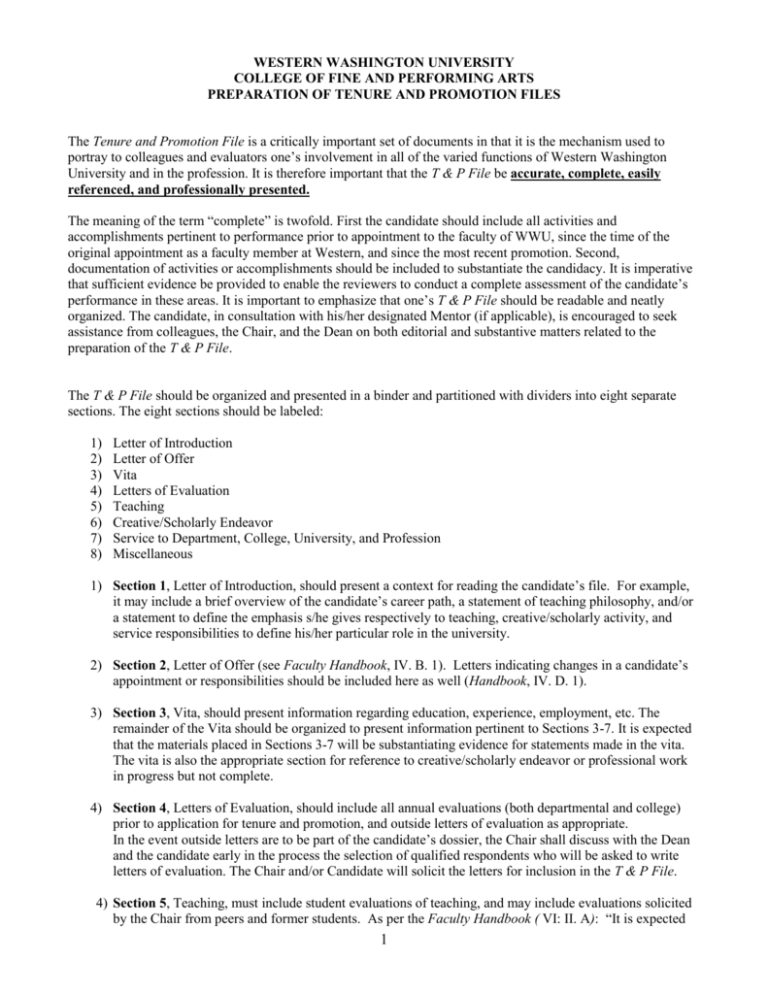
WESTERN WASHINGTON UNIVERSITY COLLEGE OF FINE AND PERFORMING ARTS PREPARATION OF TENURE AND PROMOTION FILES The Tenure and Promotion File is a critically important set of documents in that it is the mechanism used to portray to colleagues and evaluators one’s involvement in all of the varied functions of Western Washington University and in the profession. It is therefore important that the T & P File be accurate, complete, easily referenced, and professionally presented. The meaning of the term “complete” is twofold. First the candidate should include all activities and accomplishments pertinent to performance prior to appointment to the faculty of WWU, since the time of the original appointment as a faculty member at Western, and since the most recent promotion. Second, documentation of activities or accomplishments should be included to substantiate the candidacy. It is imperative that sufficient evidence be provided to enable the reviewers to conduct a complete assessment of the candidate’s performance in these areas. It is important to emphasize that one’s T & P File should be readable and neatly organized. The candidate, in consultation with his/her designated Mentor (if applicable), is encouraged to seek assistance from colleagues, the Chair, and the Dean on both editorial and substantive matters related to the preparation of the T & P File. The T & P File should be organized and presented in a binder and partitioned with dividers into eight separate sections. The eight sections should be labeled: 1) 2) 3) 4) 5) 6) 7) 8) Letter of Introduction Letter of Offer Vita Letters of Evaluation Teaching Creative/Scholarly Endeavor Service to Department, College, University, and Profession Miscellaneous 1) Section 1, Letter of Introduction, should present a context for reading the candidate’s file. For example, it may include a brief overview of the candidate’s career path, a statement of teaching philosophy, and/or a statement to define the emphasis s/he gives respectively to teaching, creative/scholarly activity, and service responsibilities to define his/her particular role in the university. 2) Section 2, Letter of Offer (see Faculty Handbook, IV. B. 1). Letters indicating changes in a candidate’s appointment or responsibilities should be included here as well (Handbook, IV. D. 1). 3) Section 3, Vita, should present information regarding education, experience, employment, etc. The remainder of the Vita should be organized to present information pertinent to Sections 3-7. It is expected that the materials placed in Sections 3-7 will be substantiating evidence for statements made in the vita. The vita is also the appropriate section for reference to creative/scholarly endeavor or professional work in progress but not complete. 4) Section 4, Letters of Evaluation, should include all annual evaluations (both departmental and college) prior to application for tenure and promotion, and outside letters of evaluation as appropriate. In the event outside letters are to be part of the candidate’s dossier, the Chair shall discuss with the Dean and the candidate early in the process the selection of qualified respondents who will be asked to write letters of evaluation. The Chair and/or Candidate will solicit the letters for inclusion in the T & P File. 4) Section 5, Teaching, must include student evaluations of teaching, and may include evaluations solicited by the Chair from peers and former students. As per the Faculty Handbook ( VI: II. A): “It is expected 1 that such evaluations will be presented from not less than two thirds of the candidate’s teaching load during the three years preceding application. These evaluations must be fully representative of the general teaching load of the candidate.” (F. Handbook, VI: II A). The evaluations should be organized in sequence by year and quarter of evaluation and by course number with title. Student evaluations of teaching should include the written comments submitted by students. It is strongly recommended that the faculty member provide at least one set of student evaluations for each separate course taught during the three years prior to the evaluation. This section should include as well: Syllabi and other course materials. Documentation of innovative course and program development, including innovative and effective teaching materials and/or instructional techniques. Teaching loads, such as the numbers of courses and students taught each quarter, new preparations, SCH, and advising. In addition, other materials that demonstrate teaching effectiveness should be included such as student special projects supervised, independent study, theses supervised, examinations, etc. 5) Section 6, Creative and/or Scholarly Endeavor, should include items from the CFPA Guidelines for Tenure and Promotion, II. B: a. Artistic presentations, exhibitions, performances, etc. b. Publication c. Additional demonstrations of professional expertise d. Papers or lectures e. Professional activities The Tenure and Promotion File should include reprints or photocopies of publications, program books, artwork, rather than an entire journal or book in which the material appears in order to reduce its bulk. 6) Section 7, Service to Department, College, University, and Profession, should include items from the CFPA Guidelines for Tenure and Promotion II.C: a) Evidence of contribution to committees within the University b) Service on the boards of local, regional, state, or national organizations. c) Invitational lectures or presentations of a general nature to non-professional organizations. d) Professional services in a consulting or advisory capacity. e) Performance, memberships on committees, consultancies, or exhibitions for community arts organizations. f) Outreach programs. Letters evaluating service may be included here. 7) Section 8, Miscellaneous, should include service, any other activities, accomplishments, services, etc. not specifically applicable to sections 3-6. May 14, 2003 (rev 6/2004) After revisions made by Dean Smeins and the CFPA Chair’s Council on May 12, 2003 And after final check by Dean Smeins on May 13, 2003 2

